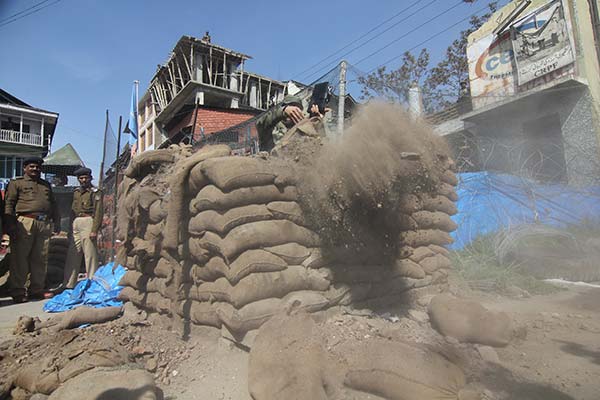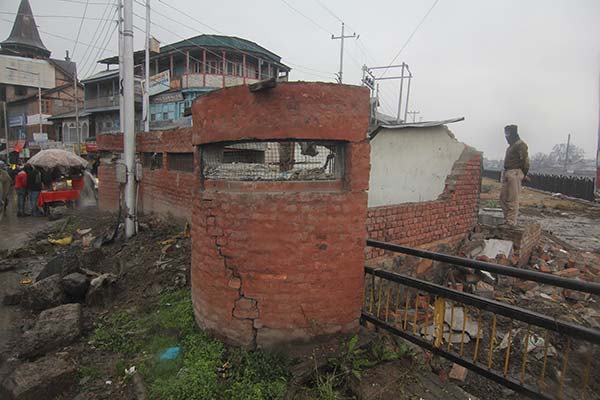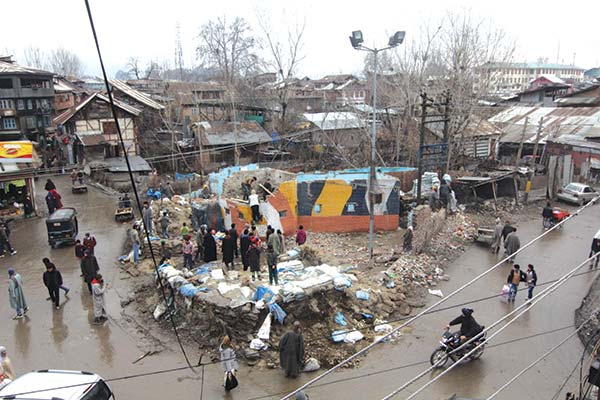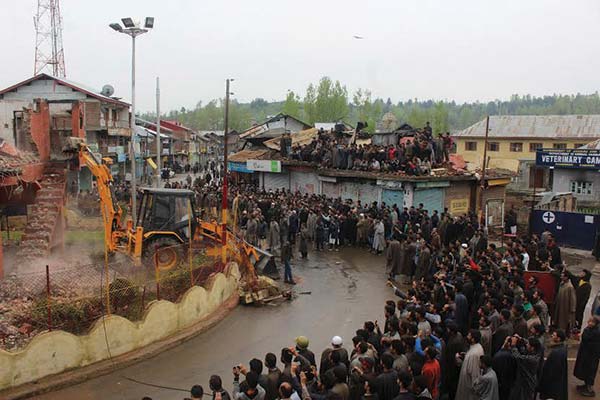Razing of Handwara bunker apparently vindicated sections in the governance structure and civil society that improved situation should dictate reducing the footprints of counter-insurgency grid in civilian areas. Hardly witnessing any troop cut since nineties, Kashmir countryside remains garrisoned. Bilal Handoo recreates the action-reaction complex linked with bunkers in Kashmir’s summer capital and in its countryside

In the deserted Habba Kadal of nineties, five minority community families stayed put amid ‘dread’, apparently running deep in their tribe. These families living in Ganpatyar area adjacent to Ganesh temple could only stay the moment paramilitary bunker sealed the temple gates. All these years this bunker has been a ‘symbol of security’ for these Pandits, but for Muslims, it was a ‘symbol of horror’.
When this ‘bunker horror’ gripped valley, armed generation attempted undoing it. One such attempt in downtown demonstrated desperation.
Suddenly, series of tippers were seen ramming the sand bunkers during the heydays of militancy. Hardly anyone could comprehend the method behind the ‘tipper trample’. Days later, the mysterious secret was over, when it was known that the method was the strategy devised by J&K Student Liberation Front’s chief, Hilal Baig—known for his “military mind”. It was, as per SLF’s former deputy, the first method to counter the ‘bunker terror’, then unleashed across valley.
Then, Baig raised his “death squad”. The squad stirred dread as its members would storm bunkers, slit throats and run away. “It was because of this group,” says a BSF Commandant, “that we would abandon the road-side bunkers during night and huddle inside relatively secure bunker, where we would remain trepid in fear.” Behind the daytime ‘hostile’ faces worn by these troopers, nobody had an idea about their nocturnal fright. When their fear peaked, forces fortified the bunkers, camps, torture centres and other security installations to prevent the possible attack by Baig’s squad.
In the “death squad”, two members were mostly at the heart of ‘bunker dread’: Nawab Bazaar’s Pareen and Izrael Khan from Solina. These men were attacking these security checkpoints as per the well-thought out insurgent strategy, coming close on the heels of custodial killings and forced disappearances in valley. Among the disappeared was SLF’s own Javaid Shalla, whose release in exchange of high-profile kidnapping case in Kashmir had earlier created ruckus in Indian parliament.
Among the dreaded duo, Izreal Khan—the “brave heart” in a skinny frame—did something unimaginable. When Murli Manohar Joshi led Ekta Yatra to Kashmir on January 26, 1992, SLF announced: “If flag hoisting can give liberation to Kashmir, then we will unfurl one at Delhi’s Red Fort.” The statement sounded a typical political stunt. But Izrael Khan had other plans unlike his comrades.
When yatris were home, Khan disguised as tourist visited Red Fort and hoisted SLF’s flag there, much to the shock of his own outfit and that of others. In Delhi, the move simply set tongues wagging.

Those were Kashmir’s Papa-II days, when according to William Dalrymple, Scottish writer and broadcaster, “…large numbers of local people, as well as the occasional captured foreign jihadi, would disappear. Their bodies would later be found, if at all, floating down rivers, bruised, covered in cigarette burns, missing fingers or even whole limbs.”
Kashmir had become military stronghold, where mere pushing of bunkers couldn’t undo a state. It was the time when the security presence across valley was off-putting with gun-toting soldiers guarding checkpoints wearing hostile faces. Amid this mounting horror, ‘signs of militarization’—pickets, sand bunkers, camps—were mushrooming across Kashmir’s length and breadth. Especially, abandoned Pandit residences and empty spaces had become hotspots of ‘occupation’. “After sensing the pattern,” says Shakeel Bakshi, Islamic Students League (ISL) patron, “some people began torching these abandoned structures and spaces to derail occupation.”
But bunkers as the outposts of state had sprung up everywhere – in schools, colleges, hospital, cinemas and other institutes. They invited militants, obviously for attacks and an engagement. These frequent military-militant operations especially changed the restive downtown; its alleys, streets, roads and structures – all looked extensions of a garrison. Even Batamaloo was no different.
As the paramilitary men started dominating the streets, these became the basic contact points for civilians to plead innocence of their detained wards.

By 2002 as India and Pakistan announced ceasefire, things started changing. Barring occasional Jaish strikes, the United Jihad Council had almost stopped attacks in valley, continues Bakshi, as Delhi had promised removal of bunkers in Kashmir. “But Delhi could never abide by its promise.”
Four years later, in 2006 spring, the PDP-Congress coalition directed the face-lifting of the ‘ugly’ bunkers to try painting a rosy image and woo tourists. Behind the move was the thought that the sand bunkers were providing a “battlefield image” to the region. Shortly concrete bunkers came up, constructed in brick and mortar. Some of them had wooden exterior painted rust-red. Bunkers from Airport Road to Shalimar were first to be face-lifted. Each unit construction cost the state exchequer over Rs 20000, taking the first phase investment to nearly Rs 300,000.
Then Kashmir’s police chief K Rajendra Kumar asserted that “bunkers can’t be removed”, but would be beautified to please tourists. The separatists denounced the exercise as a “camouflage” to justify the “illegal occupation”.
Amid this face-lift, Kashmir subsequently passed through three simmering summers. And by 2010 fall, Delhi formulated 8-points package to Kashmir. One of the points was demilitarization of Srinagar in backdrop of civil unrest. By the end of that year, 1000 CRPF personnel were vacated from city. Bunkers from Rainawari, Rajouri Kadal, Karan Nagar, Batamaloo and other places were razed to ground.
The razing of these structures evoked jubilation. In many places, the locals were seen participating in dismantling of bunkers. When Batamaloo locals found the notorious Rek Chowk bunker deserted by forces one morning, they dismantled it and celebrated the event.
Bunker removal was sluggish but huge in demand, especially in Srinagar. It was a constant cold war between the security grid and the political executive. On April 20, 2012, when authorities were removing a two-decade-old paramilitary bunker from Lal Chowk, some assailants shot dead a cop. The attack put a question mark over the process.
What further deepened the doubts was the statement of then top cop Ashok Prasad that mobile bunkers would be placed where concrete CRPF bunkers were removed since 2010. Amid removal and reinstallation of bunkers, perhaps the establishment knew what they were up to.
When Mufti dispensation razed Kawdhara camp in December 2015, says a senior cop, “it helped us to cool down the city.” While the major bunkers were done and dusted with, the one at Kawdhara housed in three buildings would frequently become target of stone-pelting, especially on Fridays. “One can see the difference now,” the cop says.
But not all are buying the police version that peace is linked with bunker removal. Even popular leader of downtown and prominent cleric, Mirwaiz Umar Farooq terms bunker removal exercise as “a cosmetic step in garrisoned valley”.

Till now, officials say 1,474 buildings besides 56 bunkers, have been vacated from forces. Among the ‘liberated’ structures, 179 are schools, 922 private buildings, 268 government buildings, 37 hospitals, 34 hotels, 31 industrial units and 3 cinema halls.
But as on today, reveals the state home ministry details, 1,307 private houses, 278 government buildings, 27 hotels, 5 cinema halls, 3 hospital and 18 industrial units continue to be under occupation of forces in state. “Security forces have also acquired 19,367 acres of land from the government,” the records reveal. “Besides, army has taken 24,738 acres of land on hearing basis while 146 acres on lease and license.”
Since nineties, the records suggest that around 1600 bunkers of army, police and paramilitary troopers were established across valley. In Srinagar alone, 406 bunkers cropped up during decadal turmoil, making it a “city of bunkers”. Since 2010, 54 have been removed, while more than 80 surviving bunkers still stand concretised in city. Rest of the bunkers are mobile (vehicle bunkers) and camp bunkers (bunkers in and outside the camps).
Now, over 20,000 concrete bunkers are coming up along the LoC and IB “for the safety of residents” living in border areas in Jammu region to prevent them from Pakistani gunners. These elaborate dungeons would cost Rs 1000 crore.
But far from the frontiers, as barricades made with barbed wire around bunkers and camps continue troubling life, the Hurriyat Conference went to State’s Human Rights Commission with a petition seeking the removal of the barbed wire from major roads across Kashmir. No action was taken. “There is no need of military establishments in civilian areas,” says National Conference legislator Devender Singh Rana while throwing his weight behind JK’s complete demilitarization. “Army should go back to barracks, so that people breathe easy and not feel caged.”
Amid Srinagar’s “surgical” demilitarisation, Kashmir’s countryside remains unchanged since nineties. Several military installations continue to occupy spaces, structures besides dominate and intervene in daily lives of civilians, thus triggering tempers quite often.
Headquarters and transit camps make for glaring signs of militarisation in rural spaces. Unlike Srinagar, army functions in the countryside along with many other forces – CRPF, ITBP, SSB and even CISF. Total estimated 656638 forces are spread in different military installations across the state.
As the troops required many things for their survival, the garrisons became new players in peripheral economy. It had unwritten costs attached with it, which became obvious when the garrisons became epicentre of Ikhwan activities. But as these camps kept mushrooming on rural landscape, they threw newer challenges to people.
When one such camp came up at Dialgam in 1992, not only it forcibly occupied land of around 150 families, it also denied compensation and rent to the families till date. And, the occupation continues.
Over the period of time, this ‘occupation’ has altered the mood in Kashmir’s countryside. Mostly it is a sense of stalking that people links with these camps, making them either angry or depressed. “When your every move is under watch, it does fume you up,” says Habidullah, a teacher in Islamabad. This is exactly what happened at Palhallan when KPs abandoned their houses there in nineties. These structures shortly served as army, paramilitary, SOG and Ikhwan command posts.
Around 20 such houses and a temple coiled with barbed wire acted as transient camps. They are still etched to Palhallan’s memory as ‘haunted houses’ instilling dread in villages. “That’s why the moment these houses were vacated by forces,” says Imran, a local, “the locals torched them to prevent further scope of occupation.”
While Srinagar has changed a lot but nothing much happened in the countryside, says a police officer from north Kashmir. “The government may have to look into relocation of bunkers in coming days.” Already Handwara has shown the results, he says. “All of a sudden a boiling township calmed when the bunker dominating the area for years was bulldozed.”
Reducing the footprints of the forces has remained key priority of the ruling PDP. It has been very vocal on this issue even during negotiating its deal with the rightwing BJP. It remains to be seen if it walks the talk.

In the city of nineties, when JKLF chief Yasin Malik came out of jail in 1994, he reached Hazratbal Dargah shrine along with his party men. Malik and Co. sat on hunger strike to press for setting garrisoned shrine free from bunkers. During that ten day sitting, JKLF chief and his men braved bullets before being finally detained.
Later, Malik was thrown in Lal Chowk and subsequently admitted in hospital. His deteriorating condition involved senior scribe Kuldeep Nair in talks with PM PV Narasimha Rao, who ordered the removal of bunkers from the shrine.
The move was the victory for Malik, who had even skipped his life-saving medicine to rally behind the bunker campaign.
Now, in Kashmir’s Fairview days, countryside is frequently hitting streets to attack security establishment besides camps whenever gunfight breaks out. The young boys attacking these camps and security forces often end up facing bullets. This is enough to make them fidayeen, believes JKLF chief.
These fidayeen, says Malik, are coming out of every camp, police stations or any military post, where they are being tortured on “Abu Ghraib pattern”.
“We had a very handsome boy Afaq Shah (17) from downtown, who became Kashmir’s first fidayeen after he rammed his explosive loaded car to Badamibagh gates on April 19, 2000,” Malik says. “The boys now attacking the camps across valley don’t seem to care about their lives. They are acting like fidayeen. They are behaving like Afaq Shah!”















